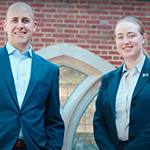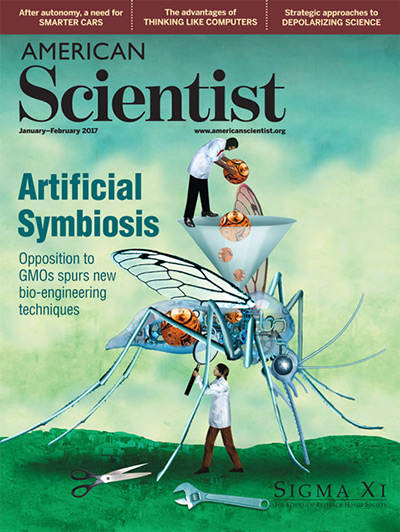

You probably know the controversial discussion surrounding genetically modified organisms, or “GMOs”—but have you heard of SMOs?
 Biology Profs. Ryan Kerney and Zakiya Whatley recently published a critical review that describes lesser-known SMOs (it’s an abbreviation for symbiotically modified organisms), and discusses their practical applications and ethical considerations. “The Prospects of Artificial Endosymbioses” appeared on this month’s cover of American Scientist magazine. Sarah Rivera ’18 and David Hewitt, a lecturer and alumnus from the University of Pennsylvania, are co-authors.
Biology Profs. Ryan Kerney and Zakiya Whatley recently published a critical review that describes lesser-known SMOs (it’s an abbreviation for symbiotically modified organisms), and discusses their practical applications and ethical considerations. “The Prospects of Artificial Endosymbioses” appeared on this month’s cover of American Scientist magazine. Sarah Rivera ’18 and David Hewitt, a lecturer and alumnus from the University of Pennsylvania, are co-authors.
According to Kerney, artificial symbiosis is just one of the methods that are part of an explosion of approaches to manipulating organisms for research and technology. “What we were summarizing are multiple techniques that are an alternative to the controversial ways that people modify organisms using molecular genetics,” he said.
While SMOs are more widely accepted as “natural” (which is probably why you don’t hear about them as often as GMOs), they often carry similar, if not in some cases, greater concerns than GMOs, depending on how they are used and for what purpose. GMOs are well known for their ties to agriculture and production of crops like corn, soy, and cotton, and draw debate about whether or not they are safe for humans and the environment.
But Kerney and Whatley warn there is little data that can prove SMOs are more or less safe than GMOs.
“A new parallel is emerging in using microbes instead of manipulating DNA—artificially introducing foreign microbes, for example bacteria, inside the cells of an animal or organism,” said Kerney. “The result is a change to the host that is actually more dramatic than a genetic modification. Although surprising, it is ethically easier to get approval for [this type of modification] because it’s called an ‘artificial symbiosis’ as opposed to ‘genetic modification,’ which is stigmatized.”
In other words, GMOs and SMOs are both a means to an end—a scientific “life hack” of sorts. Instead of, “How can I structure my work to be more productive,” scientists are asking questions like, “How can we get corn to survive a drought?” and “How can we prevent mosquitoes from spreading the Zika virus?” You can use a GMO or SMO approach to solve both problems. The difference is in how the organism is modified. Unlike GMOs, which are organisms whose genetic makeup has been modified in a lab using gene splicing or “gene editing” technologies, SMOs co-opt symbiotic relationships that can be found to occur “naturally.” For better or worse, it’s a nuance that’s at the center of ethical debate—one that GMOs are apparently losing.
Florida, which declared a state of emergency after an outbreak of the mosquito-borne Zika virus, is potentially more open to using an SMO approach. Wolbachia is a bacteria that, when introduced into a mosquito’s cells, can affect its fertility, reproductive cycle, lifespan, and even its ability to transmit the Zika virus. Although the bacteria can be found naturally in insects around the world, it is not naturally found in the species of mosquitoes that transmit these viruses to humans—thus the “modification.” Kerney and Whatley warn that while there is great promise for the use of SMOs to control mosquito borne diseases, we still can’t predict the long-term relationship between host and bacteria. For example, Wolbachia-containing mosquitoes are reproductively less fit and could require multiple releases into the population. At the same time, some GMOs have the potential to be more effective, particularly in controlling malaria, but have been curtailed by ethical concerns.
Whatley and Kerney are careful not to make explicit assertions about whether SMOs and GMOs are inherently “good” or “bad”—mostly because the data doesn’t support such a clear-cut answer. And it’s tough to predict long-term impact. But they do argue that SMOs should not be seen as “more or less risky than GMOs in any sweeping categorization.”
With the adoption of new technology, the importance of public perception is not to be understated. “None of these things happen without context of society and media, and so it’s really interesting to see how these trends occur,” said Whatley. “You can think of a time when ‘lab-approved’ was considered the gold-standard, and now there is pushback, in this case, with advances tied to laboratory modification—so I don’t know if it’s just where we are as a culture right now.”
And that culture has the potential to change—fast. Even as Kerney and Whatley hit “send” on their final draft, new research was rolling in.
“What’s going on in the life sciences right now is absolutely thrilling—the culmination of centuries of human endeavor and research,” said Kerney. “I can’t imagine there being a more exciting field to be involved in or discipline to teach than Biology right now.”
Both Kerney and Whatley teach the BIO-110 Introductory Biology course, which is how they ended up working together on this paper. Kerney, an organismal biologist who primarily works with amphibians, had knowledge of embryos, but needed Whatley’s expertise as a molecular geneticist to understand how bacteria is used in endosymbiosis.
“It would have been more difficult to get this off the ground if we didn’t have these daily conversations about science as a result of teaching the same class,” said Kerney.
Whatley joked, “The project started over the Keurig.”
Bringing everything full circle, the pair recently used the paper as an opportunity to start a discussion with their classes.
“The paper came out in January 2017, so we got to assign the paper in December that was set to come out the following year,” said Kerney. “We could show them how current the topics were that they were discussing, and they got a kick out of reacting to their professors’ work.”
“Beyond the topical content we cover in our class, one of the main things we want our students to do is to be critical thinkers,” said Whatley. “This is a synthesis piece—so how do you interrogate these different views? Our students can decide whether they agree or disagree because they have knowledge of the biological approaches and have discussed views they may not have initially considered. Those are the conversations we push in the classroom."


